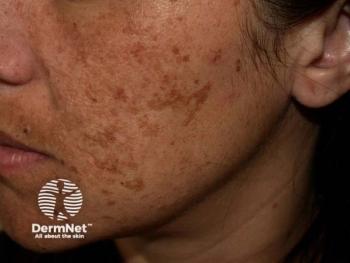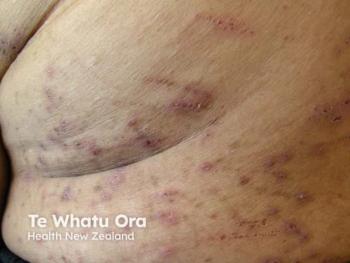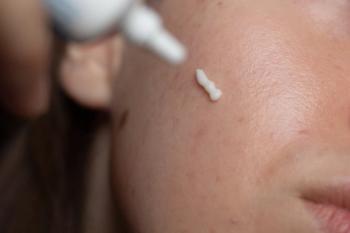
- Dermatology Times, August 2025 (Vol. 46. No. 08)
- Volume 46
- Issue 08
Targeting Shared Pathways: Tofacitinib for Co-Occurring Vitiligo and Discoid Lupus Erythematosus
Key Takeaways
- Vitiligo and DLE share JAK-STAT–mediated inflammatory mechanisms, offering a common target for intervention.
- Tofacitinib, a JAK inhibitor, effectively treated vitiligo secondary to DLE, achieving significant repigmentation.
Tofacitinib shows promise in treating vitiligo secondary to discoid lupus erythematosus, achieving significant repigmentation and lesion resolution.
Vitiligo often coexists with other autoimmune diseases, but its development secondary to discoid lupus erythematosus (DLE) is rarely reported.1 DLE, a chronic form of cutaneous lupus, is marked by inflammatory plaques with scarring, pigment alteration, and potential for permanent disfigurement. Both vitiligo and DLE have been linked to dysregulated interferon (IFN) signaling through the Janus kinase (JAK)-STAT pathway, offering a shared mechanistic target for intervention.2-4
Conventional therapies such as corticosteroids, calcineurin inhibitors, and antimalarials often fail to control disease in recalcitrant cases or dual presentations. Recent evidence suggests that JAK inhibitors such as tofacitinib may modulate inflammatory circuits involved in these diseases.5 This case illustrates successful repigmentation and resolution of lesions with tofacitinib in a patient with vitiligo secondary to DLE.6
Case Presentation
A man aged 49 years presented with a 2-month history of scattered erythematous plaques on the dorsal hands, ears, and forearms, without systemic symptoms. Histopathologic examination confirmed a diagnosis of DLE, demonstrating hyperkeratosis, liquefaction degeneration of basal cells, and dermal inflammatory infiltrates.
Initial treatment with hydroxychloroquine 200 mg twice daily and topical tacrolimus produced limited improvement. Over time, the patient developed depigmented macules within DLE lesions, raising concern for vitiligo. Skin computed tomography revealed loss of basal layer pigmentation, residual pigment, and dermal inflammation—findings consistent with progressive vitiligo.
Given his poor response to conventional therapies, the patient was started on oral tofacitinib 5 mg twice daily, while continuing hydroxychloroquine. After 1 month, the erythematous plaques flattened with reduced scaling, and perifollicular repigmentation was noted in the depigmented areas. Over 1 year, more than 75% repigmentation was achieved with no new lesions or adverse effects. The DLE plaques remained inactive without recurrence throughout follow-up.
Clinical Implications
This case highlights a rare and diagnostically challenging presentation: vitiligo developing within existing DLE lesions. The successful resolution of both conditions with a single agent—an oral JAK inhibitor—raises important considerations for clinicians managing autoimmune overlap syndromes.
Dual autoimmune pathogenesis: DLE and vitiligo share JAK-STAT–mediated inflammatory mechanisms. In DLE, type I and II IFNs drive keratinocyte damage, and in vitiligo, IFN-γ–induced chemokines recruit autoreactive CD8+ T cells, perpetuating melanocyte destruction.1,2
Therapeutic rationale: Tofacitinib selectively inhibits JAK1 and JAK3, suppressing IFN-driven signaling involved in both diseases. Its efficacy in this case supports prior observations in systemic lupus erythematosus and vitiligo individually.6-8
Clinical benefit without adverse effects: Over 12 months of therapy, the patient experienced significant improvement with no reported hematologic, hepatic, or infectious complications.
Limited literature, expanding potential: Reports on tofacitinib in DLE or vitiligo are sparse, and even fewer address concurrent disease. This case adds valuable insight to a growing interest in JAK inhibitors for complex dermatologic conditions.3,5,9
Conclusion
This report presents a rare case of vitiligo arising within lesions of DLE, both successfully treated with tofacitinib. The patient achieved marked repigmentation and resolution of inflammatory plaques with no adverse effects. The shared pathogenic role of IFN-driven JAK-STAT signaling in both conditions provides a compelling rationale for JAK inhibition as an off-label therapeutic approach. Although this case is limited by its single-patient design, it highlights a promising treatment avenue worthy of further investigation in larger studies.
Jennifer Fisher, MMSc, PA-C, is a board-certified dermatology physician assistant and medical writer in Connecticut.
References
1. Bergqvist C, Ezzedine K. Vitiligo: a review. Dermatology. 2020;236(6):571-592. doi:10.1159/000506103
2. Qi F, Liu F, Gao L. Janus kinase inhibitors in the treatment of vitiligo: a review. Front Immunol. 2021;12:790125. doi:10.3389/fimmu.2021.790125
3. Hu W, Zhang S, Lian C. Treatment of discoid lupus erythematosus with upadacitinib: a case report. Clin Cosmet Investig Dermatol. 2023;16:2793-2800. doi:10.2147/CCID.S419344
4. Kahn JS, Deverapalli SC, Rosmarin DM. JAK-STAT signaling pathway inhibition: a role for treatment of discoid lupus erythematosus and dermatomyositis. Int J Dermatol. 2018;57(8):1007-1014. doi:10.1111/ijd.14064
5. Zhu Y, Shi Z, Xu Z, et al. Oral tofacitinib, baricitinib and upadacitinib monotherapy for steroid-resistant vitiligo: a prospective case series. J Eur Acad Dermatol Venereol. 2025;39(2):e128-e130. doi:10.1111/jdv.20109
6. Jin S, Wang S, Jin S, Tang C, Wang P. A case of vitiligo secondary to discoid lupus erythematosus treated with tofacitinib. Medicine (Baltimore). 2025;104(26):e43118. doi:10.1097/MD.0000000000043118
7. Li X, Luo K, Yang D, Hou C. A case report of systemic lupus erythematosus complicating interstitial lung disease and thickened pericardium treated with tofacitinib. Medicine (Baltimore). 2024;103(30):e39129. doi:10.1097/MD.0000000000039129
8. Hasni SA, Gupta S, Davis M, et al. Phase 1 double-blind randomized safety trial of the Janus kinase inhibitor tofacitinib in systemic lupus erythematosus. Nat Commun. 2021;12(1):3391. doi:10.1038/s41467-021-23361-z
9. Chen X, Qiao J. Two cases of lupus miliaris disseminatus faciei successfully treated with oral tofacitinib. J Dermatolog Treat. 2023;34(1):2244616. doi:10.1080/09546634.2023.2244616
Articles in this issue
4 months ago
Examining Bond-Building Hair Care Treatments4 months ago
Dermatology Times August 2025 Print RecapNewsletter
Like what you’re reading? Subscribe to Dermatology Times for weekly updates on therapies, innovations, and real-world practice tips.


















